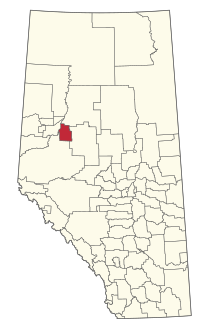Municipal District of Smoky River No. 130
Municipal District of Smoky River No. 130 | |
|---|---|
 Welcome sign | |
 Location within Alberta | |
| Country | |
| Province | |
| Region | Northern Alberta |
| Census division | 19 |
| Established | 1952 |
| Incorporated | 1952 |
| Government | |
| • Reeve | Robert Brochu |
| • Governing body | MD of Smoky River Council |
| • Administrative office | Falher |
| Area (2016)[2] | |
| • Land | 2,840.14 km2 (1,096.58 sq mi) |
| Population (2016)[2] | |
| • Total | 2,023 |
| • Density | 0.7/km2 (2/sq mi) |
| Time zone | UTC−7 (MST) |
| • Summer (DST) | UTC−6 (MDT) |
| Website | mdsmokyriver.com |
The Municipal District of Smoky River No. 130 is a municipal district (MD) in northwestern Alberta, Canada. Located in Census Division No. 19, its municipal office is located in the Town of Falher.
History[]
On January 1, 1952, its name was changed from MD of Fillion No. 130 to its current name, which was taken from Smoky River, a tributary of Peace River.
Demographics[]
In the 2016 Census of Population conducted by Statistics Canada, the MD of Smoky River No. 130 recorded a population of 2,023 living in 720 of its 891 total private dwellings, a -4.8% change from its 2011 population of 2,126. With a land area of 2,840.14 km2 (1,096.58 sq mi), it had a population density of 0.7/km2 (1.8/sq mi) in 2016.[2]
In the 2011 Census, the MD of Smoky River No. 130 had a population of 2,126 living in 740 of its 819 total dwellings, a −12.9% change from its 2006 population of 2,442. With a land area of 2,842.59 km2 (1,097.53 sq mi), it had a population density of 0.7/km2 (1.9/sq mi) in 2011.[10]
Communities and localities[]
|
The following urban municipalities are surrounded by the MD of Smoky River No. 130:[11]
The following hamlets are located within the MD of Smoky River No. 130:[11]
|
The following localities are located within the MD of Smoky River No. 130:[12]
|
See also[]
References[]
- ^ Alberta Municipal Affairs: Municipal Officials Search
- ^ Jump up to: a b c d "Population and dwelling counts, for Canada, provinces and territories, and census subdivisions (municipalities), 2016 and 2011 censuses – 100% data (Alberta)". Statistics Canada. February 8, 2017. Retrieved February 8, 2017.
- ^ "Table 6: Population by sex, for census subdivisions, 1956 and 1951". Census of Canada, 1956. Volume I: Population. Ottawa: Dominion Bureau of Statistics. 1958.
|volume=has extra text (help) - ^ "Table 9: Population by census subdivisions, 1966 by sex, and 1961". 1966 Census of Canada. Western Provinces. Population: Divisions and Subdivisions. Ottawa: Dominion Bureau of Statistics. 1967.
- ^ "Table 3: Population for census divisions and subdivisions, 1971 and 1976". 1976 Census of Canada. Census Divisions and Subdivisions, Western Provinces and the Territories. Population: Geographic Distributions. Ottawa: Statistics Canada. 1977.
- ^ "Table 2: Census Subdivisions in Alphabetical Order, Showing Population Rank, Canada, 1981". 1981 Census of Canada. Census subdivisions in decreasing population order. Ottawa: Statistics Canada. 1982. ISBN 0-660-51563-6.
- ^ "Table 2: Population and Dwelling Counts, for Census Divisions and Census Subdivisions, 1986 and 1991 – 100% Data". 91 Census. Population and Dwelling Counts – Census Divisions and Census Subdivisions. Ottawa: Statistics Canada. 1992. pp. 100–108. ISBN 0-660-57115-3.
- ^ "Population and Dwelling Counts, for Canada, Provinces and Territories, and Census Divisions, 2001 and 1996 Censuses – 100% Data (Alberta)". Statistics Canada. Retrieved 2019-05-25.
- ^ "Population and dwelling counts, for Canada, provinces and territories, and census subdivisions (municipalities), 2006 and 2001 censuses – 100% data (Alberta)". Statistics Canada. January 6, 2010. Retrieved 2019-05-25.
- ^ "Population and dwelling counts, for Canada, provinces and territories, and census subdivisions (municipalities), 2011 and 2006 censuses (Alberta)". Statistics Canada. February 8, 2012. Retrieved February 8, 2012.
- ^ Jump up to: a b "Specialized and Rural Municipalities and Their Communities" (PDF). Alberta Municipal Affairs. 2012-03-01. Archived from the original (PDF) on 2012-04-09. Retrieved 2012-08-12.
- ^ "Standard Geographical Classification (SGC) 2006, Economic Regions: 4819041 - Smoky River No. 130, geographical codes and localities, 2006". Statistics Canada. 2010-03-05. Retrieved 2012-08-12.
External links[]
- Municipal District of Smoky River No. 130
- Municipal districts in Alberta
